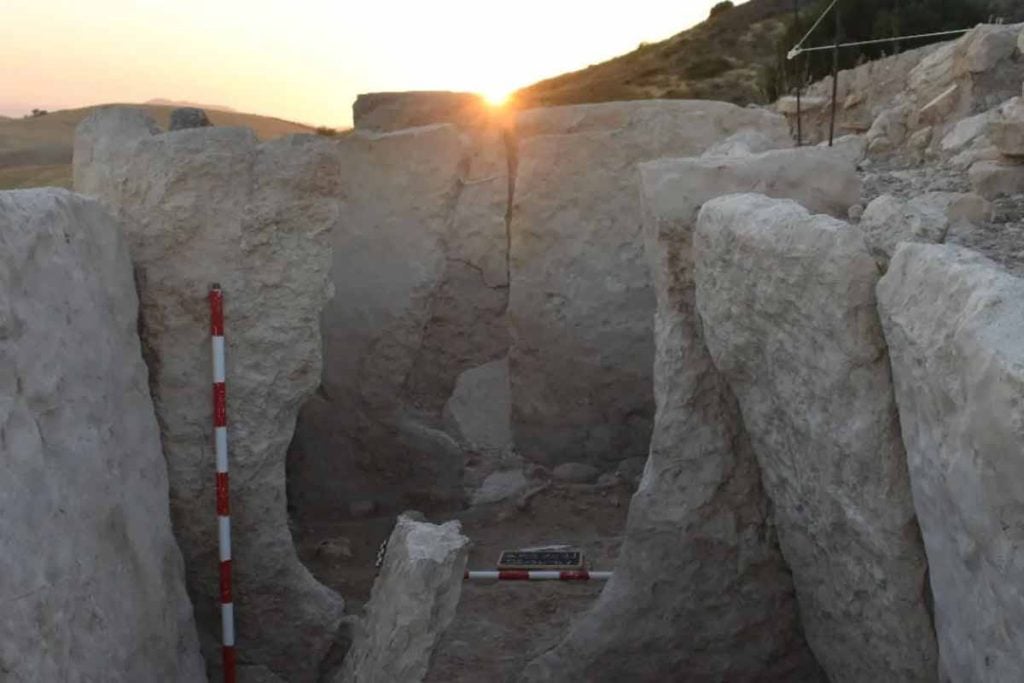A trove of ritual objects, sharp tools, and ancestral remains waits inside a megalith built five millennia ago. This Tomb stands out for its scale and its remarkably intact layout, so experts expect rare insight into early beliefs. While the title teases wonders, the structure itself holds the rest: layered stones, precise chambers, and a design meant to last. The site’s careful construction suggests planning, teamwork, and a powerful memory of the dead that still reaches us today.
A Monumental Tomb in Southern Iberia
The monument dates to the third millennium B.C.E., when megalithic builders shaped orthostat slabs into a long passage. It extends roughly 42 feet, and the upright stones rise over six feet. Specialists from the University of Cádiz call it among Andalusia’s most complete dolmens, given its preservation and the clarity of its architectural lines.
Archaeologists describe multiple internal compartments that organize movement and ceremony. Each area could separate stages of burial, signal status, or control who entered sacred space. Because the structure remains intact, researchers will track how mourners navigated the route, where bodies lay, and which items accompanied them, step by step, across the stone threshold.
This Tomb also speaks through its exterior. Large horizontal slabs once roofed the passage, and a tumulus of sand and small stones sealed it. The mound amplified the monument in the landscape, so communities saw it from afar. Visibility mattered, since memory, identity, and territory meet at places where ancestors rest.
How the Structure Was Built and Used
Upright slabs, known as orthostats, anchor the walls. They support capstones that form a stable ceiling, while joints between blocks tighten as weight presses down. Builders understood leverage, friction, and balance. Because the fit remains secure, archaeologists can read the original engineering decisions directly from the stones.
Excavations across several seasons revealed an ordered interior. Researchers found ossuaries – container rooms for grouped remains – showing the site functioned as a collective burial ground. The layout suggests sequence : entry, ritual handling, deposition, and closing. Since circulation leaves distinct traces, studies can test how people moved, and why certain corners received bones or offerings.
Although dolmens spread across continents, this case offers rare clarity. The intact sealing layers, the capped passage, and the filled chambers preserve context that erosion often erases. As a result, the team can match objects to actions. That mapping turns architecture into a guidebook, so the Tomb becomes a timeline of gestures, choices, and beliefs.
Grave Goods That Reframe Prehistoric Life
The chambers hold bones and prestigious goods. Ivory and amber point to exotic raw materials prized for shine and rarity, while seashells travel inland as symbols of the sea’s power. Sophisticated flint pieces—arrowheads, large-format blades, even an exceptional halberd—show artisanship, hunting needs, display, and perhaps authority.
Project leaders emphasize how well-preserved contexts unlock meaning. Because the objects stayed where mourners left them, associations remain visible. Tools near an ossuary speak differently from beads near a threshold, so placement adds grammar to the message. The team underlines that conservation, not just discovery, carries the lesson forward.
A professor notes that seashells far from the coast imply long-distance exchange networks and maritime prestige. People moved goods, stories, and influence across the Iberian interior. That circulation matters because it ties daily life to ceremony. The Tomb therefore records both trade and ritual, so economics and spirituality share the same room.
Scale, Dates, and Famous Parallels
Measured at 42 feet, the passage belongs among large European megaliths, and its third-millennium B.C.E. date places it within a long tradition. Across regions, builders used big stones, careful alignments, and mounds to anchor memory in the land. Because this monument remains complete, it provides an uncommon reference point.
Spain’s Dolmen of Guadalperal—about 7,000 years old—rises during drought from a reservoir and is often called the “Spanish Stonehenge.” In England, Arthur’s Stone dates to roughly 5,000 years and features nine uprights that together weigh an estimated 27 tons. Those parallels frame how communities everywhere linked ancestors to place.
Not every site served a single role. Some megaliths sheltered travelers; others marked territory or staged rites beyond burial. Comparisons help isolate what is unique here : the preserved roof slabs, the sealed mound, the distinct compartments, and the rich artifact set. That mix clarifies why this Tomb stands out among peers.
Why This Tomb Matters Beyond Archaeology
Researchers expect the monument to refine how we read ancient customs. Because intact layers survive, analyses can test food residue, tool wear, and pigment traces. Each result narrows guesswork. When evidence fixes a practice to a chamber, hypothesis turns into sequence, so the story grows precise without losing nuance.
Grave goods outline social life. Ivory and amber suggest status, exchange routes, and craft specialization. Flint weaponry signals hunting, defense, or ceremony. Seashells from the coast, found inland, show prestige linked to the sea and the power of distant horizons. As lines of movement emerge, we meet the community that built the mound.
Memory also needs care. Conservation protects fragile bones and minerals; documentation fixes context; and public history returns meaning to local people. When a site remains readable, it feeds schools, museums, and identity. The Tomb thus becomes a shared resource, not only a scientific find, and its lessons travel farther than its stones.
A closing look at what endures when the earth keeps its secrets
The monument’s size, sealed spaces, and rich offerings join to form a complete picture of the past. Because the structure stayed intact, it keeps voices that stone can hold: trade, craft, ritual, and grief. As researchers proceed, this Tomb will continue turning evidence into story, while the mound still guards the rest.
